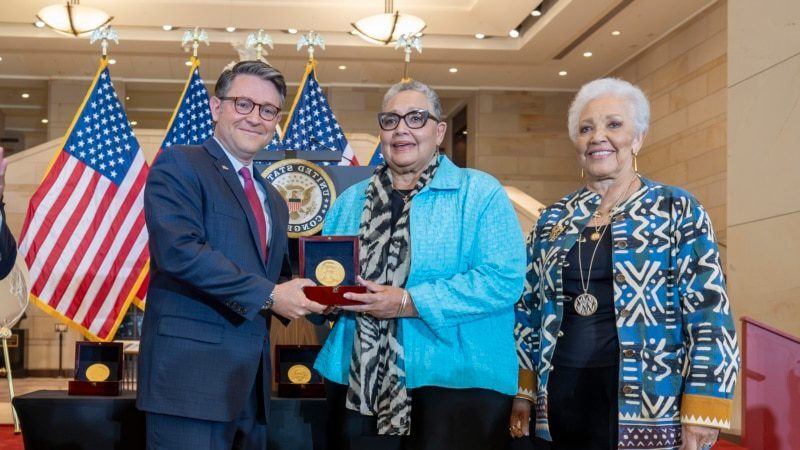BTN News: Four trailblazing Black women who played pivotal roles in the United States space race were awarded the Congressional Gold Medal, one of the highest honors presented by Congress. Katherine Johnson, Dorothy Vaughan, Mary Jackson, and Christine Darden were recognized for their groundbreaking contributions as mathematicians, engineers, and “human computers” during NASA’s formative years. Their efforts, especially in the segregated work units of the National Advisory Committee for Aeronautics (NACA), were critical to the success of U.S. space missions, including John Glenn’s historic orbit around Earth. On Wednesday, families of these women received the honors during a ceremony at Capitol Hill, with Darden, the only surviving honoree, participating remotely. This award also recognizes the collective contributions of all women who worked in similar roles from the 1930s to the 1970s. Their story, popularized in the book and film “Hidden Figures,” continues to inspire generations.
Celebrating Unsung Heroes of the Space Race
In a landmark ceremony held at Capitol Hill, the U.S. Congress posthumously awarded the Congressional Gold Medal to three Black women and recognized Christine Darden, the only living recipient, for their instrumental roles in NASA’s early space missions. These women, whose contributions were largely unacknowledged for decades, were pivotal in breaking racial and gender barriers during one of the most challenging periods in U.S. history.
The recognition not only celebrates these individual achievements but also highlights the broader group of Black women and other female professionals who worked as “human computers” in a segregated America. Their complex calculations were critical for missions such as John Glenn’s 1962 orbital flight, which marked a milestone in U.S. space exploration.
Pioneering Figures Behind NASA’s Success
Katherine Johnson:
Katherine Johnson’s calculations played a crucial role in some of NASA’s most significant missions, including John Glenn’s 1962 mission, where she manually verified the computer-generated calculations for his orbit around Earth. Her work ensured that Glenn became the first American astronaut to achieve this feat safely. Johnson’s legacy of precision and excellence earned her the Presidential Medal of Freedom in 2015.
Dorothy Vaughan:
Dorothy Vaughan, a brilliant mathematician, became NASA’s first Black female supervisor. Vaughan’s leadership at NACA’s segregated West Area Computing Unit paved the way for many other women in STEM. She was instrumental in introducing early computer programming techniques to NASA, a skill she mastered during her tenure.
Mary Jackson:
Mary Jackson broke barriers as NASA’s first Black female engineer. Her career spanned over 30 years, during which she made substantial contributions to NASA’s wind tunnel experiments. Jackson’s determination to break racial and gender stereotypes earned her a well-deserved place in history, not just as an engineer but as an advocate for diversity in science and engineering.
Christine Darden and the Legacy of Sound Barrier Research
Christine Darden is renowned for her groundbreaking research on supersonic flight and the complexities of sonic booms. Joining NASA in 1967, Darden made significant contributions to aeronautical engineering and became one of the leading experts in sonic boom prediction. Her work remains integral to the field of aerospace, and she continues to inspire young women pursuing careers in STEM.
Darden, now retired, joined the ceremony remotely from her home in Connecticut. She remains an emblem of resilience and intellect, showing that Black women were not just present in NASA’s history—they were essential to its success.
Recognizing a Legacy of Female “Human Computers”
The Congressional Gold Medal ceremony was not only a tribute to these four remarkable women but also to the many others who contributed behind the scenes as mathematicians, engineers, and “human computers” from the 1930s to the 1970s. These women worked in segregated facilities and performed vital calculations that directly impacted the success of NASA’s missions.
Margot Lee Shetterly, the author of “Hidden Figures,” whose work popularized these stories, noted during the ceremony, “By honoring them, we honor the very best of America’s spirit.” Her book and its subsequent film adaptation shed light on these hidden figures and showcased how their work changed the course of history.
A New Chapter in U.S. History: Breaking Barriers in STEM
The recognition of Johnson, Vaughan, Jackson, and Darden is part of a broader movement to acknowledge the overlooked contributions of women and people of color in STEM fields. Their accomplishments are not just about breaking gender and racial barriers—they are about setting a precedent for future generations. As America continues to push the boundaries of space exploration, their stories remain a powerful reminder of the talent and tenacity that fuel scientific progress.
Conclusion
This Congressional Gold Medal ceremony marked a historic moment in recognizing the contributions of Black women who helped shape U.S. space exploration. Their work, once relegated to the shadows, has now received the national recognition it deserves. As their legacies continue to inspire, it’s clear that these “hidden figures” will remain central to America’s scientific achievements.


